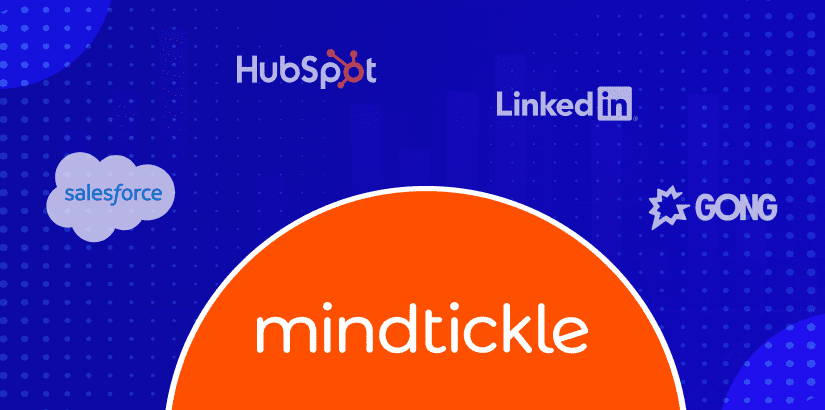The Complete Guide to Mobile Sales Tools and How They Improve Seller Performance
![]() Rahul Mathew
on
March 26, 2024
Rahul Mathew
on
March 26, 2024
Sales reps have always depended on the right tools to meet their sales quota. Today, a mobile device can be one of their most powerful tools. A survey found that nearly half of sales reps feel their phone is “the most effective tool for performing their jobs.
However, that mobile device must have the right mobile sales tools.
Mobile sales tools help ensure sales reps can effectively engage with buyers and move deals forward – no matter where or what device they’re using. That means they can close more deals faster. That’s music to any CRO’s ears.
When it comes to mobile sales apps, you might find yourself asking questions like:
- What is a mobile sales tool?
- How do mobile sales tools benefit my sales teams?
- What are the best mobile sales tools on the market today?
We’ll answer all of these questions and more in this post.
What is a mobile sales tool?
The phrase “mobile sales tool” is one that’s used often. But what is a mobile sales tool?
Essentially, a mobile sales tool is software or an application that helps sellers do their jobs – right from the convenience of their mobile devices. A mobile sales tool enables sales teams to effectively and efficiently facilitate and streamline the sales process, regardless of location and device.
While mobile sales tools help sellers engage with buyers, it’s important to note that customers and prospects aren’t using them. Instead, mobile sales apps are used by sales reps to engage customers and guide them through the purchase journey.
Mobile sales app categories
Mobile sales apps allow sales reps to access the right information and complete key tasks from their mobile device. There are many different categories of mobile sales apps, including (but not limited to):
These allow sellers to access training and enablement activities to sharpen the skills necessary for sales success. Sales managers can also use these tools to measure sales enablement success.
These enable sales reps to find and share the right content with the right prospect at the right time.
These enable sellers to effectively communicate with buying committees throughout the sales cycle.
These help sales teams more effectively predict revenue and identify at-risk deals.
These help sellers find and connect with buyers who fit their product or service offerings well.
These equip sellers with all the information they need about a prospect – right from their mobile device.
We’ll take a closer look at some of the top mobile sales software later on.
What are the benefits of mobile sales software?
Research from Salesforce found that, on average, sales reps spend a mere 28% of their time each week selling. That means they spend most of their time bogged down with other tasks, like data entry and searching for the right information and content.
The right mobile sales tools help streamline time-consuming tasks so reps can spend more time selling.
Let’s look at some of the key benefits of mobile sales tools.
Greater flexibility
Many sales reps aren’t sitting in front of a computer at a corporate office every day. Instead, they might meet with customers in the field, travel to a tradeshow, or work from their home office. Mobile sales apps allow reps to work wherever they may be on a given day.
Increased sales productivity
Mobile sales apps equip sales reps with the right tools and information at their fingertips. They don’t have to wait to get back to their stationary computer to get things done.
For example, a sales rep meets with a prospect at their office. Without mobile sales tools, they’d have to wait until they returned to the office to log their notes in their CRM and address action items from the meeting. But with the right mobile sales tools, they can complete these tasks immediately following the meeting – right from their mobile device.
As another example, consider a sales rep engaging with a prospect at an industry trade show. If the rep waits to follow up with the prospect until they return to the office, the prospect may lose interest and become disengaged. With mobile sales tools, that rep can easily search and find content that addresses the prospect’s key challenges – and share it with the prospect immediately. By engaging with the prospect as quickly as possible, that sales rep can move the deal forward faster – and increase the likelihood of closing it.
Easy access to the right sales content
In the world of B2B sales, content has never been more important. According to the Demand Gen Report, over half (55%) of buyers rely on content to research and guide their purchase decisions more than they did in the past.
According to resesarch,
But sales reps can’t get by sharing generic sales content. Instead, reps must provide personalized, relevant content that resonates with each buyer.
Today, many organizations focus on creating plenty of content. However, reps often spend too much time hunting for content that’ll resonate with their buyers. Research tells us reps spend an average of 440 hours per year trying to find the right content.
Reps spend
With the right mobile sales tools, reps can easily find and share content that’ll resonate with each buyer – wherever they are on the purchase journey. That means sellers can spend less time searching and more time engaging with buyers and adding value.
Enhanced sales team and customer communication
Clear communication is key to sales success. Sales reps must engage effectively with buyers to understand their needs, deliver value, and move deals forward. Sales reps must also communicate internally to ensure the right people are pulled in at the right time.
The right mobile sales tools can help improve both internal and external communication. When everyone is on the same page, deals can more easily move forward.
What are the best mobile sales tools?
Mobile sales tools can improve the effectiveness and efficiency of your sellers – regardless of their location and device. But what are the best mobile sales tools on the market today?
There’s no easy answer. The right mobile sales tool addresses the needs of your sales team and the organization as a whole.
Single use case vs integrated mobile sales tools
When shopping for mobile sales tools, you’ll find that some tools fulfill a single use case. For example, you may have a mobile sales tool for sales content management. Or, your team may use a mobile sales app for video calling.

There are also integrated mobile sales tools, which address many use cases. For example, a mobile sales enablement tool may incorporate content management, training, coaching, and conversation intelligence – all from one application.
When possible, consider adopting integrated mobile sales apps. These solutions address many challenges – without the need to toggle between several apps.
With that in mind, let’s take a closer look at some of the top mobile sales apps used by winning sales teams.
Mindtickle
Mindtickle is an example of an integrated mobile sales app because it helps improve sales performance in several different ways.
For starters, Mindtickle enables sales teams to find and engage with training and enablement that helps them grow the skills they need to be successful in the field. Sellers can consume training and enablement on their own time from their mobile devices. Managers can access sales enablement analytics to help them understand how reps are engaging with enablement and whether this enablement is improving seller performance.

Mindtickle also incorporates content management capabilities. That means sellers can easily find and share content that’ll resonate with buyers – proven to move deals forward.
In addition, Mindtickle features conversation intelligence, which records and analyzes sales calls. That means sales reps can focus on their conversations rather than taking notes. Sales managers can also leverage conversation insights to understand reps’ behaviors. Then, they can deliver customized coaching to improve performance.

Mindtickle also includes revenue intelligence capabilities, which help sales teams more accurately predict revenue. With revenue intelligence, sales managers can identify at-risk deals and work with sales reps to improve outcomes.
Salesforce
Salesforce is a popular customer relationship management (CRM) tool among businesses of all sizes and industries. Salesforce offers a robust mobile sales app that enables sellers to manage every deal effectively – whether in the office or on the go.
With the Salesforce mobile sales app, sales reps can easily pull up key information about a prospect. For example, they can refresh their memory with details of their last interaction with the buyer. Sales reps can also use the mobile app to add notes and updates.
LinkedIn Sales Navigator
Prospecting isn’t an easy feat. Sellers must identify the right points of contact – and then convince those people to engage with them. It’s no wonder why 40% of sales reps cite prospecting as the most difficult part of the sales process.
LinkedIn Sales Navigator is a sales tool that enables reps to leverage LinkedIn’s network to identify the right prospects – and then effectively engage with them. With the LinkedIn Sales Navigator app, your sales reps can manage their prospecting efforts via mobile device.
ZoomInfo
Sales reps only have so many hours in the day. It’s important to prioritize their time on good-fit customers.
Yet, seven in 10 sellers feel that 50% of the prospects they interact with aren’t a good fit for their product or service offerings.
ZoomInfo is a popular mobile sales tool that helps sales reps engage with the right buyers. The mobile app enables sales reps to access powerful insights, including customer data, buyer intent, and website behavior. These insights can help sales reps find their ideal prospects.
Are your sellers equipped with the right mobile sales tools?
Modern sellers aren’t chained to a desk. Instead, they’re visiting clients, attending industry events, and traveling. With the right mobile sales tools, these sales reps can facilitate and accelerate deals from their mobile device.
Mobile sales with Mindtickle
Ready to see how Mindtickle equips sales teams with the training, enablement, content, and conversation intelligence they need to succeed – all from their mobile devices?
Get a Demo



































